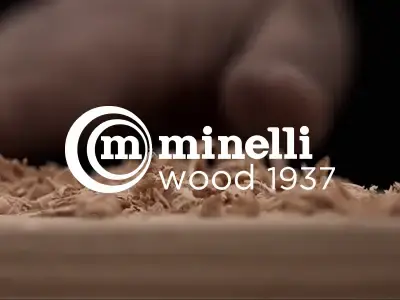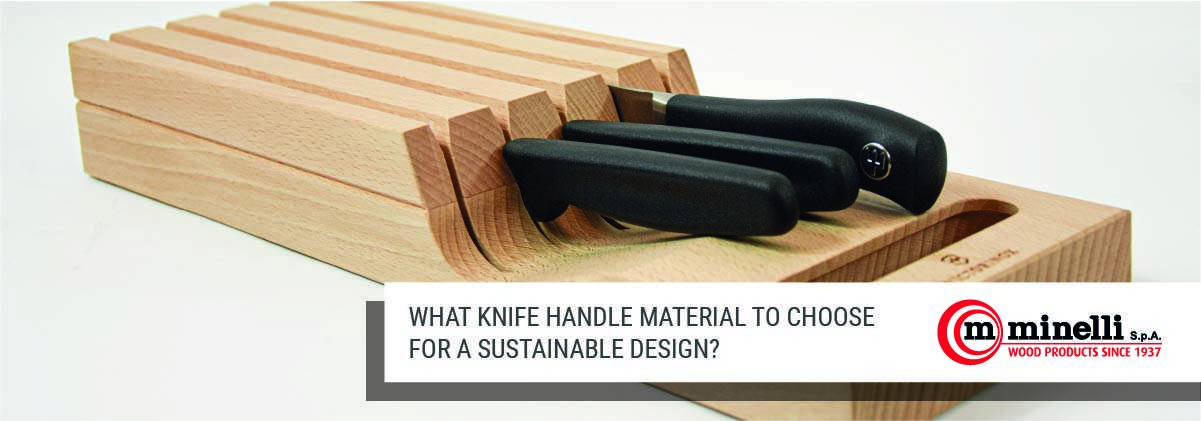 Sustainability is a buzzword today, even referring to the design of homeware. Consumers are increasingly aware of environmental issues, and they try to make more conscious choices to contribute to safeguarding the planet. Therefore, companies are more prone to offer sustainable product that combine a “green” soul with elegance and design. What about kitchenware tools? Let’s discuss the topic in this article.
Sustainability is a buzzword today, even referring to the design of homeware. Consumers are increasingly aware of environmental issues, and they try to make more conscious choices to contribute to safeguarding the planet. Therefore, companies are more prone to offer sustainable product that combine a “green” soul with elegance and design. What about kitchenware tools? Let’s discuss the topic in this article.
Knife handle material & sustainability: what is the link?
Offering natural and biodegradable knife handle material—such as wood—is the best way to satisfy the needs of those clients that want to make more conscious choices and contribute to safeguarding the environment.
Choosing a sustainable raw material, however, is not enough. You must ensure that the manufacturer you select respects the rules and parameters of environmental protection dictated by the market in all phases of the production process, from the collection of the raw material to the distribution of finished products.
If you decide to include wooden kitchenware tools in your catalogue, ensure that your supplier has received FSC certification, which proves that wood comes from responsibly managed forests that provide environmental, social, and economic benefits to local communities.
In the video below, you can see what we mean by sustainable production process.
Here are the topics we will discuss in this article. You can click the link to read the corresponding paragraph.
- What does sustainable design mean?
- Why is wood the best knife handle material?
- The best woods for knife handles
What does sustainable design mean?
Sustainable design means creating products considering their environmental, social, and economic impact from the initial phase through the entire process.
It means considering the impact that the product will have in its full life cycle, enabling the manufacturer to ensure that all efforts have been made to produce a product that doesn’t damage the environment.
The term sustainable design has been used in multiple disciplines, including product design, architecture design, interior design, and graphic design, as an approach that integrates an environmentally friendly vision and considers natural resources as part of the design. This approach is very far from what most manufacturers do today.
In this interesting video, Christiaan Maats underlines how companies that operate with a great commitment to workers and the environment can build stronger relationships with customers and change their belief system.
Coming back to kitchen tools and utensils, the knife handle material you offer in your catalogue can make a significant difference.
Why is wood the best knife handle material?
Many people believe that the most important part of the knife is the blade. It is certainly a fundamental component—as it lets the knife perform its function—but the handle is equally important.
When you decide to widen your catalogue with new knife handles, you must pay great attention to the material you choose to offer.
Wood can’t be ignored. Customers really love wood, and they consider wooden tools and utensils as objects of design to display in their homes. Besides being sustainable, a high-quality wooden knife handle is more durable, comfortable to hold, elegant, and safer when compared to other materials.
The prestige of wood has no equal
Wood provides a unique tactile and sensorial experience that is unthinkable with other materials, such as metal or plastic. Some brands consider metal as the best choice for knife handles because of its durability and strength, but we must consider two important factors:
- Wood is durable as well. If treated properly by a competent supplier, wooden utensils can last for years. In fact, some special finishes can make the raw material more resistant to impact, falls, chemicals, and moisture, ensuring very long service.
- Metal is heavy and slippery. It means that knives with stainless steel handles won’t be lightweight and can be uncomfortable to use, especially if you need to hold them for very long. Moreover, to provide a certain grip, manufacturers must often incorporate etching or ridges, resulting in very unappealing objects.
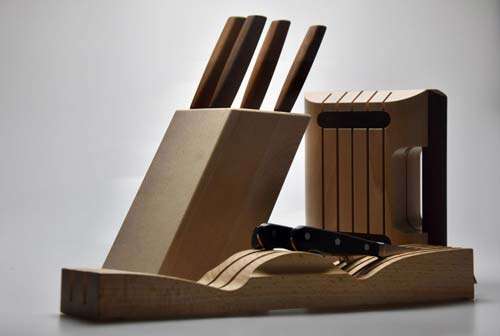 Wooden tools can become decorative elements in the kitchen both in modern and more rustic houses. A competent manufacturer will be able to create unique and unusual shapes and treat wooden handles with the most innovative finishes, customizing them with laser engravings and special coatings according to customers’ requests. These features will let your clients stand out in the market and be competitive.
Wooden tools can become decorative elements in the kitchen both in modern and more rustic houses. A competent manufacturer will be able to create unique and unusual shapes and treat wooden handles with the most innovative finishes, customizing them with laser engravings and special coatings according to customers’ requests. These features will let your clients stand out in the market and be competitive.
Wooden knives are also appreciated because of their link with the past: all grandmas almost certainly had wooden utensils in their kitchens, such as knives, spoons, and spatulas. Wooden knife handles can mix innovation and tradition at the same time, which consumers really love.
Wood is also safer than metal or plastic
Two main reasons:
- Wood doesn’t conduct heat. If consumers leave a wooden utensil near a hot pot, the handle will remain cool. On the contrary, a metal object will become very hot and might burn your hand, while a plastic tool will melt. Moreover, being a nonreactive material, wood won’t react with acids in foods or leave a metallic taste, like metal spoons. Wood also has natural shock resistance: if clients hit a hard surface using a knife with a wooden handle, only slight vibration will occur, making the knife much more comfortable to use.
- Wood is also safer for consumers’ health, as it seems to have some antimicrobial properties; in particular, close-grained woods are less likely to absorb moisture and bacteria, preventing the formation of mold and stains.
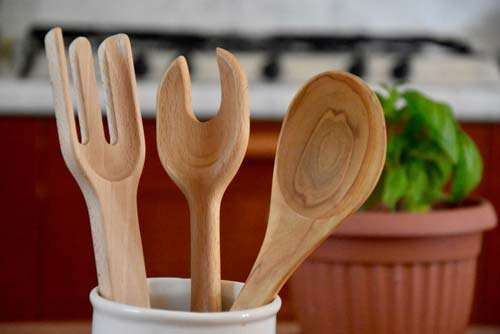 Wood is the most cost-effective knife handle material
Wood is the most cost-effective knife handle material
You might think that buying wooden components would be more expensive than plastic or metal ones, but that’s not entirely true. Some types of wood—like olive and walnut—are more expensive than other (e.g., beech and ash) but wood is anyway cost-effective. In fact, wood doesn’t need moulds and it can be machined, milled and reshaped quickly if something must be modified. Moulds are very expensive, and if something goes wrong, you must make a new mould, wasting time and money.
It means that producing wooden components requires a very low initial investment. You must also consider that by choosing a reliable and competent partner you can produce just small lots of products and only when needed with a greater focus on efficiency and a reduction of any related stocking cost. You can also decide to produce and put on the market just half of the lot, and after a certain period, you can decide how to complete the finishing (e.g., laser marking, painting, oiling, and waxing). During this time, you will be able to understand which kind of finishing works better in the market and produce just those objects that can be successful. Even if the raw material is more expensive, it doesn’t mean that the overall costs will be higher: you must consider the entire process to have a precise idea of your expenses.
The best woods for knife handles
Many different types of woods are used for knife handles, and most of them are hardwood. If compared to softwood, hardwoods are more dense, more resistant, more durable, and harder as well. Sometimes, knife handles are made with resins to increase their resistance to water, humidity and chemicals.
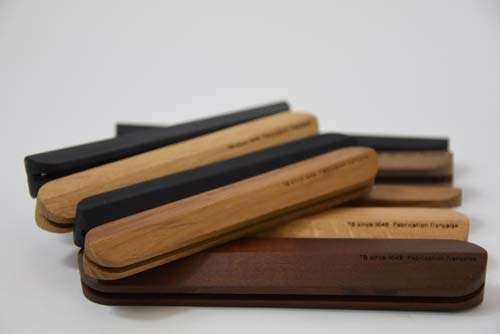
Listed below are the most used woods for knife handles:
Beech
Beech needs little maintenance and it is the cheapest wood type, so it is ideal for simple kitchen knives that are frequently used. Even if it is not one of the most precious types of wood, beech knives look great as well.
Ash
Ash is a valid alternative to Beech as it offers a more evident wood grain and texture at a similar cost. The touch & feel, therefore, grants a more “wood-related” experience. Ash is perfect for frequent usage kitchen knives and can be easily supplied and machined to obtain very elegant shapes and finishing.
Walnut
Walnut is used mainly for gun stocks and furniture, as it is elegant and resistant at the same time. Some people love it for knives, too, and it is appreciated by those who have a collection of knives used sporadically.
Oak
Oak is very common for knife handles. It is solid, aesthetically beautiful, elegant, and cheaper than other types of wood. It is often used for kitchen knives, and it can be easily engraved and customized according to customers’ needs.
Cocobolo
Cocobolo is one of the most durable woods you can find. It is naturally resistant to insects and moisture, which is why it is in high demand all over the world. Cocobolo is expensive, but a knife made with this wood will last for a very long time, even if used a lot.
Burl
This is a very precious type of wood that is ideal for enthusiasts and collectors. Burl knife handles are solid and of high quality and are often used to produce custom wooden knives.
Ebony
This type of wood is maybe the most elegant and precious and very sought after despite the high cost. Besides its prestige, it is strong and durable and perfect to create a custom knife.
Wood provides the perfect combination of comfort, design, durability, functionality, safety, and sustainability, but you must find a competent supplier that is able to manage it perfectly to create precise and high-quality knife handles. Consider that wooden knife handles must be combined with a metal blade: if you rely on an manufacturer that doesn’t know the specific tolerances of wood, the result will be poor and of low quality.
If you are looking for an FSC-certified wood maker with expertise in wood manufacturing, do not hesitate to contact us. Click here!
